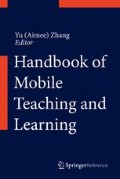Abstract
Mobile information technologies can unshackle students from desks and classrooms and allow them to learn on the go. They can explore and consume information, record their learning, and collaborate with mentors and with each other at any time and in any place. Further, because the mobile device knows user location and identity, learning can be location and situation based as well as personalized to the user. In this chapter, we describe current mobile computing technologies and their use in teaching and learning. We project how mobile technologies will evolve in the future and examine – using the various theories and processes of learning as a lens – how the growing affordances of these technologies will impact student learning and education in the future.
Access this chapter
Tax calculation will be finalised at checkout
Purchases are for personal use only
References
Ahlqvist, O., R. Benkar, R. Ramnath, K. Vatev, A. Heckler, and B. Mikula. 2013. Online Map Games – Playful interaction with geographical science tools. In Games + Learning + Society conference 9.0, Madison, June 2013.
Ahlqvist, Ola, Zhaoyi Chen, Peixuan Jiang, and Rajiv Ramnath. 2014. Online Map Games – Playful interaction with complex real-world issues. In AGILE conference on geographic information science, Castellon, 3 June 2014.
Anderson, L.W., D.R. Krathwohl, et al. 2001. A taxonomy for learning, teaching and assessing: A revision of Bloom’s taxonomy of educational objectives. New York: Longman.
Argyris, C., and D. Schön. 1978. Organizational learning: A theory of action perspective. Reading: Addison Wesley.
Bransford, John D., Ann L. Brown, and Rodney R. Cocking (eds.). 2000. How people learn: Brain, mind, experience and school, 1st ed. Washington, DC: National Academies Press.
Clough, G. 2010. Geolearners: Location-based informal learning with mobile and social technologies. IEEE Transactions on Learning Technologies 3(1): 33–44.
Fischer, G., and E. Scharff. 1998. Learning technologies in support of self-directed learning. Interactive Media in Education 98(4). http://jime.open.ac.uk/98/4
Forbes. 2014. Training & Development Journal; Feb69, 23(2), p60. http://www.forbes.com/sites/chuckjones/2014/06/04/apples-u-s-iphone-market-share-holding-steady/
Gerard, R.W. 1967. Shaping the mind: Computers in education. In Computer-assisted instruction: A book of readings, ed. R.C. Atkinson and H.A. Wilson. New York: Training & Development Journal.
Herold, M., T. Lynch, R. Ramnath, and J. Ramanathan. 2012. Student and instructor experiences in the inverted classroom. In Frontiers in Education Conference (FIE 2012), Seattle, Oct 2012.
Hunsaker, Johanna Steggert. 1981. The experiential learning model and the learning style inventory: An assessment of current findings. Journal of Experiential Learning and Simulation 2: 145–152.
Kolb, D.A. 1984. Experiential learning. Englewood Cliffs: Prentice-Hall.
Lage, M.J., G.J. Platt, and M. Treglia. 2000. Inverting the classroom: A gateway to creating an inclusive learning environment. Journal of Economic Education 31(1): 30–43.
Luo, Shuanglan, and Xueqin Huang. 2012. A survey research on the online learning adaptation of the college students. In: 2nd international IEEE conference on Consumer Electronics, Communications and Networks (CECNet), Three Gorges, YiChang, Hubei, China.
Meejaleurn, S., A. Uratchanoprakorn, and S. Boonlue. 2010. The construction of the online-learning in a group activity using blended learning on the information communication and network system at Grade 9. In 2nd International Conference on Computer Technology and Development (ICCTD), 2–4 Nov 2010.
Mikula, B., A. Heckler, O. Ahlqvist, R. Benkar, R. Ramnath, and K. Vatev. 2013. GeoGame: An online geography game for learning about the green revolution. In Poster Paper, Games + Learning + Society conference 2013, Memorial Union, Madison, June 2013.
Prensky, Marc. 2001. Digital natives, digital immigrants. On the Horizon (MCB University Press) 9(5):1–6
Rogers, A. 2003. What is the difference? A new critique of adult learning and teaching. The National Institute of Adult Continuing Education. ISBN 1 86201 184 2.
Schon, D.A. 1983. The reflective practitioner. New York: Basic Books.
Schon, D.A. 1987. Educating the reflective practitioner, Jossey-Bass Higher Education Series. San Francisco: Wiley.
Tan, Tan-Hsu, and Tsung-Yu Liu. 2004. The mobile-based interactive learning environment (MOBILE) and a case study for assisting elementary school english learning. In ICALT’04 proceedings of the IEEE international conference on advanced learning technologies, 530–534, 2004
Terrell, S. 2005. Supporting different learning styles in an online learning environment. Online Journal of Distance Learning Administration VIII(II). Also at http://www.westga.edu/~distance/ojdla/summer82/terrell82.htm
The Kirkpatrick Model. 2015. http://www.kirkpatrickpartners.com/OurPhilosophy/TheKirkpatrickModel/tabid/302/Default.aspx
Wiley, D.A. 2000. Connecting learning objects to instructional design theory: A definition, a metaphor, and a taxonomy. In The instructional use of learning objects: Online Version. http://reusability.org/read/chapters/wiley.doc. Retrieved 07 June 2004.
Yan, W., C. Li, J. Ma, S. Ma, and H. Truong. 2012. m-LTE: A mobile-based learning and teaching interactive environment. In IEEE international conference on Teaching, Assessment and Learning for Engineering (TALE), Hong Kong.
Author information
Authors and Affiliations
Corresponding author
Editor information
Editors and Affiliations
Rights and permissions
Copyright information
© 2015 Springer-Verlag Berlin Heidelberg
About this entry
Cite this entry
Ramnath, R., Kuriakose, A. (2015). Mobile Technologies for Teaching and Learning. In: Zhang, Y. (eds) Handbook of Mobile Teaching and Learning. Springer, Berlin, Heidelberg. https://doi.org/10.1007/978-3-642-54146-9_35
Download citation
DOI: https://doi.org/10.1007/978-3-642-54146-9_35
Published:
Publisher Name: Springer, Berlin, Heidelberg
Print ISBN: 978-3-642-54145-2
Online ISBN: 978-3-642-54146-9
eBook Packages: Humanities, Social Sciences and Law

